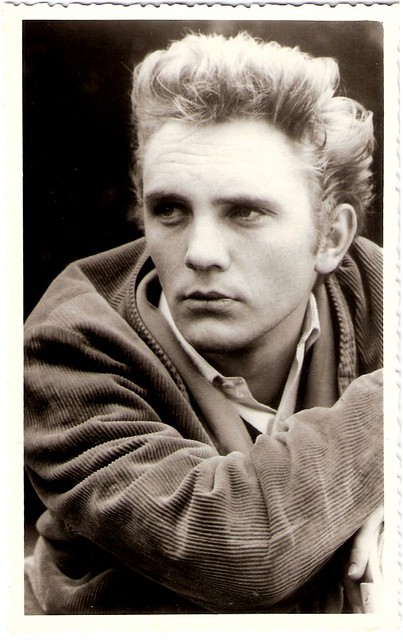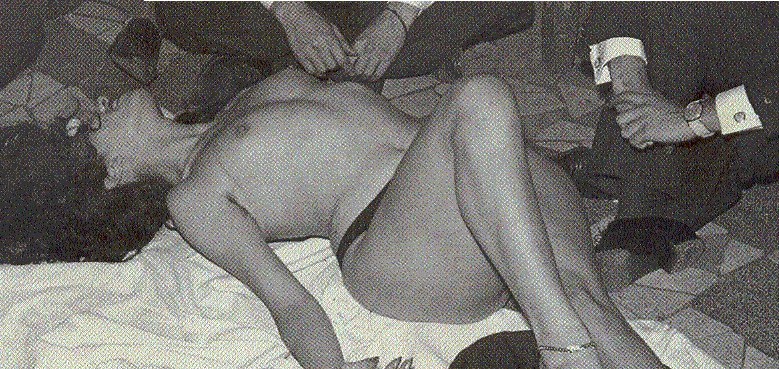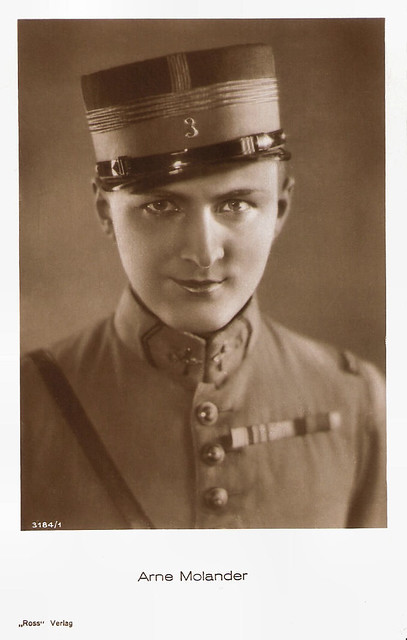Ernst Schneider was one of the most acclaimed studio photographers of Berlin during the 1910s, 1920s and 1930s. Many celebrities from the theatre, the opera, the circus, and later the cinema came to his studio. Schneider also belonged to the esteemed fashion photographers of the German capital, and published books with his nude photography.
![Karina Bell]()
Karina Bell. German postcard by Ross Verlag, no. 2094/1, 1927-1928. Photo: Ernst Schneider, Berlin. Collection: Didier Hanson.
![Ossi Oswalda]()
Ossi Oswalda. German postcard by Ross Verlag, Berlin, no. 3871/1, 1928-1929. Photo: Atelier Ernst Schneider, Berlin / FPS.
![Hans Stüwe]()
Hans Stüwe. German postcard by Ross Verlag, no. 645, 1919-1924. Photo: Atelier Schneider, Berlin.
Ernst Schneider started his career in photography sometime at the turn of the 20th Century. Exact data are not available at the net.
His first fashion shots were published in magazines like Welt der Frau (World of Women) and Gartenlaube (Gazebo).
In 1908, he published Die Gestalt des Menschen und Ihre Schönheit: Vorlagen zum Studium des nackten menschlichen Körpers (The Human Form and Beauty: templates to study the naked human body). This book with nude photography was also published in the U.S. by the publisher J. Singer and Company in 1908.
In addition to beautiful women Schneider photographed opera and theatre stars such as Franz Lehar, Richard Tauber and Hans Albers. Even Mata Hari posed for Schneider’s camera.
![Madge Lessing]()
Madge Lessing. German advertising postcard by Richard Habisch & Co., Berlin, for Gargoyle Bohner Wasch, sent by mail in 1911. Photo: Ernst Schneider, Berlin.
![Sascha Gura]()
Sascha Gura. German postcard by Photochemie, Berlin, no. K 3072. Photo: Ernst Schneider.
![Iris Arlan]()
Iris Arlan. Austrian postcard by Iris Verlag, no. 5513. Photo: Ernst Schneider, Berlin.
![Ossi Oswalda]()
Ossi Oswalda. German postcard by Ross Verlag, Berlin, no. 761/2, 1925-1926. Photo: Ernst Schneider, Berlin.
![Hanni Weisse]()
Hanni Weisse. German postcard by Ross Verlag, no. 3087/1, 1928-1929. Photo: Ernst Schneider, Berlin.
![Richard Tauber]()
Richard Tauber. German postcard by Odeon. Photo: Ernst Schneider, Berlin.
Around 1908 Atelier Ernst Schneider started to work closely together with such postcard publishers as Rotophot and Neue Photographische Gesellschaft (NPG) and from 1919 on with Ross Verlag.
From 1910 on, the studio was located at Unter den Linden 62-63. Atelier Ernst Schneider moved to the fashionable Kurfürstendamm in 1932. The company remained there until the end of the 1930s.
Schneider worked for the city's best fashion houses and he had a large villa in Wannsee, where many fashion photographs were taken. During the 1930s his work appeared in Vanity Fair and Die Illustrierte Berliner Zeitung.
What later happened to Ernst Schneider and his studio is unclear. If you have more information, please let us know.
![Evelyn Holt]()
Evelyn Holt. German postcard by Ross Verlag, no. 3688/1, 1928 - 1929. Photo: Atelier Ernst Schneider, Berlin.
![Agnes Esterhazy]()
Agnes Esterhazy. German postcard by Ross Verlag, nr. 3705/2, 1928-1929. Photo: Atelier Ernst Schneider.
![Marcella Albani]()
Marcella Albani. German postcard by Ross Verlag, no. 3704/1, 1928-1929. Photo: Ernst Schneider, Berlin.
![Werner Fuetterer]()
Werner Fuetterer. German postcard by Ross Verlag, nr. 4050/1, 1929-1930. Photo: Ernst Schneider, Berlin / Europäische Film-Production. Publicity still for Morgenröte/Dawnings (Wolfgang Neff, Burton George, 1929).
![Olga Tschechowa]()
Olga Tschechova. German postcard by Ross Verlag no. 4652/1, 1929-1930. Photo: Ernst Schneider, Berlin.
![Lya Mara]()
Lya Mara. German postcard by Ross Verlag, no. 4308/4, 1929-1930. Photo: Ernst Schneider, Berlin.
This is the third post in a new series on star photographers. The first post was on the Reutlinger Studio in Paris and the second on Italian star photographerAttilio Badodi.
Sources: Detlef Krenz (diegeschichteberlins.de) (German), Postkarten-Archiv.de (German) and Luminous Lint.

Karina Bell. German postcard by Ross Verlag, no. 2094/1, 1927-1928. Photo: Ernst Schneider, Berlin. Collection: Didier Hanson.

Ossi Oswalda. German postcard by Ross Verlag, Berlin, no. 3871/1, 1928-1929. Photo: Atelier Ernst Schneider, Berlin / FPS.

Hans Stüwe. German postcard by Ross Verlag, no. 645, 1919-1924. Photo: Atelier Schneider, Berlin.
Nude Photography
Ernst Schneider started his career in photography sometime at the turn of the 20th Century. Exact data are not available at the net.
His first fashion shots were published in magazines like Welt der Frau (World of Women) and Gartenlaube (Gazebo).
In 1908, he published Die Gestalt des Menschen und Ihre Schönheit: Vorlagen zum Studium des nackten menschlichen Körpers (The Human Form and Beauty: templates to study the naked human body). This book with nude photography was also published in the U.S. by the publisher J. Singer and Company in 1908.
In addition to beautiful women Schneider photographed opera and theatre stars such as Franz Lehar, Richard Tauber and Hans Albers. Even Mata Hari posed for Schneider’s camera.

Madge Lessing. German advertising postcard by Richard Habisch & Co., Berlin, for Gargoyle Bohner Wasch, sent by mail in 1911. Photo: Ernst Schneider, Berlin.

Sascha Gura. German postcard by Photochemie, Berlin, no. K 3072. Photo: Ernst Schneider.

Iris Arlan. Austrian postcard by Iris Verlag, no. 5513. Photo: Ernst Schneider, Berlin.

Ossi Oswalda. German postcard by Ross Verlag, Berlin, no. 761/2, 1925-1926. Photo: Ernst Schneider, Berlin.

Hanni Weisse. German postcard by Ross Verlag, no. 3087/1, 1928-1929. Photo: Ernst Schneider, Berlin.

Richard Tauber. German postcard by Odeon. Photo: Ernst Schneider, Berlin.
The City's Best Fashion Houses
Around 1908 Atelier Ernst Schneider started to work closely together with such postcard publishers as Rotophot and Neue Photographische Gesellschaft (NPG) and from 1919 on with Ross Verlag.
From 1910 on, the studio was located at Unter den Linden 62-63. Atelier Ernst Schneider moved to the fashionable Kurfürstendamm in 1932. The company remained there until the end of the 1930s.
Schneider worked for the city's best fashion houses and he had a large villa in Wannsee, where many fashion photographs were taken. During the 1930s his work appeared in Vanity Fair and Die Illustrierte Berliner Zeitung.
What later happened to Ernst Schneider and his studio is unclear. If you have more information, please let us know.

Evelyn Holt. German postcard by Ross Verlag, no. 3688/1, 1928 - 1929. Photo: Atelier Ernst Schneider, Berlin.

Agnes Esterhazy. German postcard by Ross Verlag, nr. 3705/2, 1928-1929. Photo: Atelier Ernst Schneider.

Marcella Albani. German postcard by Ross Verlag, no. 3704/1, 1928-1929. Photo: Ernst Schneider, Berlin.

Werner Fuetterer. German postcard by Ross Verlag, nr. 4050/1, 1929-1930. Photo: Ernst Schneider, Berlin / Europäische Film-Production. Publicity still for Morgenröte/Dawnings (Wolfgang Neff, Burton George, 1929).

Olga Tschechova. German postcard by Ross Verlag no. 4652/1, 1929-1930. Photo: Ernst Schneider, Berlin.

Lya Mara. German postcard by Ross Verlag, no. 4308/4, 1929-1930. Photo: Ernst Schneider, Berlin.
This is the third post in a new series on star photographers. The first post was on the Reutlinger Studio in Paris and the second on Italian star photographerAttilio Badodi.
Sources: Detlef Krenz (diegeschichteberlins.de) (German), Postkarten-Archiv.de (German) and Luminous Lint.



























































































